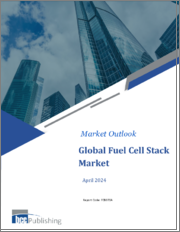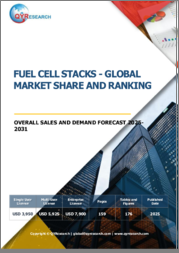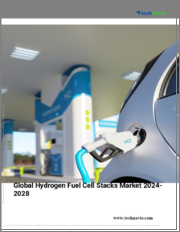
|
시장보고서
상품코드
1621847
연료전지 스택 시장 성장 기회, 성장 촉진요인, 산업 동향 분석 및 예측(2024-2032년)Fuel Cell Stack Market Opportunity, Growth Drivers, Industry Trend Analysis, and Forecast 2024 to 2032 |
||||||
세계 연료전지 스택 시장은 2023년 41억 달러로 평가되었고, 2024-2032년간 연평균 11.5%의 성장률을 나타낼 것으로 예상됩니다.
연료전지는 화학 에너지를 직접 전기로 변환하고 물과 열만 배출하는 혁신적인 장치로, 매우 지속 가능한 에너지 솔루션입니다. 여러 층의 셀로 구성된 연료전지 스택은 고출력과 고전압을 달성하도록 설계되어 무공해 에너지 시스템으로의 전환에 있어 매우 중요한 기술이 되고 있습니다. 기후 변화에 대한 인식이 높아지고 무공해 솔루션에 대한 수요가 증가하는 것이 이 시장의 주요 촉진요인입니다. 보조금 및 세제 혜택과 같은 정부 지원책은 산업 전반에 걸쳐 연료전지 기술 채택을 가속화하고 있습니다.
수소 인프라의 확대와 자동차, 특히 대형 차량 부문에서 연료전지 사용이 증가하면서 시장 수요를 더욱 촉진하고 있습니다. 연료전지 스택 시장을 유형별로 분류하면 공냉식과 수냉식으로 나눌 수 있습니다. 수냉식 연료전지는 기술 발전과 특히 상업용 및 산업용 백업 시스템에서 고출력 용도 증가로 인해 2032년까지 65억 달러를 넘어설 것으로 예상됩니다. 효과적인 열 관리, 효율적인 작동 온도, 최적화된 성능 등의 장점으로 인해 수냉식 연료전지는 매우 바람직한 선택이 되고 있습니다.
강화된 제조 공정, 신소재, 규모의 경제를 통해 생산 비용을 낮추기 위한 연구 개발 노력이 이 부문의 성장을 가속할 것으로 예상됩니다. 연료전지 스택 시장은 또한 자동차, 고정형, 발전, 기타 등 용도별로 분류됩니다. 설치형 부문은 탄소 발자국 감소와 지속가능성 목표 달성을 우선시하는 경향이 강화되면서 2032년까지 연평균 10.5% 이상의 성장률을 나타낼 것으로 예상됩니다. 온실가스 감축을 촉진하는 정책들이 연료전지 기술에 유리한 환경을 조성하고 있습니다.
| 시장 범위 | |
|---|---|
| 시작 연도 | 2023년 |
| 예측 연도 | 2024년-2032년 |
| 시작 금액 | 4.1억 달러 |
| 예상 금액 | 10.6억 달러 |
| CAGR | 11.5% |
또한, 연료전지는 재생 가능 에너지와 결합하여 하이브리드 에너지 시스템을 구축하여 신뢰할 수 있는 백업 솔루션과 효율적인 에너지 관리를 제공할 수 있습니다. 연료전지 개발자, 에너지 기업 및 연구 개발 기관의 협업이 이러한 발전을 가속화하고 있습니다. 지역별로는 아시아태평양의 연료전지 스택 시장 규모가 2032년까지 70억 달러에 달할 것으로 예상됩니다. 연구에 대한 재정 지원과 상업적 도입에 대한 보조금과 같은 정부 지원이 이러한 성장을 가속하고 있습니다. 이 지역의 급속한 도시화와 지속 가능한 에너지 솔루션에 대한 필요성이 특히 도시 인프라 및 교통 시스템에서 연료전지 수요를 촉진하고 있습니다.
아시아태평양에서 지속가능성에 대한 기업의 노력이 증가하고 있으며, 친환경 대체 에너지에 대한 기업 수요가 증가함에 따라 시장 확대에 기여하고 있습니다.
목차
제1장 조사 방법과 조사 범위
제2장 주요 요약
제3장 산업 인사이트
- 산업 에코시스템
- 규제 상황
- 산업에 대한 영향요인
- 성장 촉진요인
- 산업 잠재적 리스크와 과제
- 성장 가능성 분석
- Porter's Five Forces 분석
- PESTEL 분석
제4장 경쟁 구도
- 서론
- 전략 대시보드
- 혁신과 기술 전망
제5장 시장 규모와 예측 : 유형별, 2021-2032년
- 주요 동향
- 공랭
- 액랭
제6장 시장 규모와 예측 : 용량별, 2021-2032년
- 주요 동향
- 5kW 이하
- 5-100kW
- 100-200kW
- 200 kW 이상
제7장 시장 규모와 예측 : 용도별, 2021-2032년
- 주요 동향
- 자동차
- 고정형
- 발전
- 기타
제8장 시장 규모와 예측 : 지역별, 2021-2032년
- 주요 동향
- 북미
- 미국
- 캐나다
- 유럽
- 독일
- 영국
- 프랑스
- 이탈리아
- 스페인
- 오스트리아
- 아시아태평양
- 중국
- 일본
- 한국
- 인도
- 필리핀
- 베트남
- 중동 및 아프리카
- 사우디아라비아
- 아랍에미리트
- 남아프리카공화국
- 라틴아메리카
- 브라질
- 멕시코
- 페루
제9장 기업 개요
- Advent Technologies Holding
- Ballard Power Systems
- Commonwealth Automation Technologies
- Dana Incorporated
- ElringKlinger
- FuelCell Energy Solutions
- Freudenberg Group
- Horizon Fuel Cell Technologies
- Intelligent Energy Limited
- Nedstack Fuel Cell Technology
- Nuvera Fuel Cells
- PowerCell Sweden
- Plug Power
- Robert Bosch
- Schunk Bahn-und Industrietechnik
- TW Horizon Fuel Cell Technologies
The Global Fuel Cell Stack Market, valued at USD 4.1 billion in 2023, is projected to expand at a CAGR of 11.5% from 2024 to 2032. Fuel cells are innovative devices that convert chemical energy directly into electricity, emitting only water and heat as byproducts, making them a highly sustainable energy solution. Composed of multiple layered cells, a fuel cell stack is designed to achieve high power outputs and voltage, positioning it as a pivotal technology in the transition to zero-emission energy systems. Growing awareness around climate change and the rising demand for zero-emission solutions are key drivers of this market. Supportive government initiatives, such as subsidies and tax incentives, are accelerating the adoption of fuel cell technology across industries.
The expanding hydrogen infrastructure and the increased use of fuel cells in vehicle applications, particularly in heavy-duty sectors, are further boosting market demand. Segmented by type, the fuel cell stack market includes air-cooled and liquid-cooled variants. Liquid-cooled fuel cells are expected to surpass USD 6.5 billion by 2032, driven by technological advancements and a rise in high-power applications, especially within commercial and industrial backup systems. Benefits such as effective thermal management, efficient operating temperatures, and optimized performance make liquid-cooled fuel cells highly desirable.
Efforts in research and development to lower production costs through enhanced manufacturing processes, new materials, and economies of scale are projected to enhance growth in this segment. The fuel cell stack market is also categorized by application, including automotive, stationary, power generation, and others. The stationary segment is forecasted to grow at a CAGR of over 10.5% through 2032 due to the increasing priority placed on reducing carbon footprints and achieving sustainability goals. Policies promoting the reduction of greenhouse gases are fostering an environment favorable to fuel cell technology.
| Market Scope | |
|---|---|
| Start Year | 2023 |
| Forecast Year | 2024-2032 |
| Start Value | $4.1 Billion |
| Forecast Value | $10.6 Billion |
| CAGR | 11.5% |
Moreover, fuel cells can be paired with renewable sources to create hybrid energy systems, providing reliable backup solutions and efficient energy management. Collaborations between fuel cell developers, energy companies, and research institutions are accelerating these advancements. Regionally, the Asia Pacific fuel cell stack market is expected to surpass USD 7 billion by 2032. Governmental support, including financial assistance for research and subsidies for commercial adoption, is stimulating this growth. Rapid urbanization and the need for sustainable energy solutions across the region are driving the demand for fuel cells, particularly within urban infrastructure and transport systems.
Increasing corporate commitments to sustainability across the Asia Pacific also contribute to the market expansion as companies seek environmentally friendly energy alternatives.
Table of Contents
Chapter 1 Methodology & Scope
- 1.1 Research design
- 1.2 Base estimates & calculations
- 1.3 Forecast model
- 1.4 Primary research & validation
- 1.4.1 Primary sources
- 1.4.2 Data mining sources
- 1.5 Market Definitions
Chapter 2 Executive Summary
- 2.1 Industry 360° synopsis, 2021 - 2032
Chapter 3 Industry Insights
- 3.1 Industry ecosystem
- 3.2 Regulatory landscape
- 3.3 Industry impact forces
- 3.3.1 Growth drivers
- 3.3.2 Industry pitfalls & challenges
- 3.4 Growth potential analysis
- 3.5 Porter's analysis
- 3.5.1 Bargaining power of suppliers
- 3.5.2 Bargaining power of buyers
- 3.5.3 Threat of new entrants
- 3.5.4 Threat of substitutes
- 3.6 PESTEL analysis
Chapter 4 Competitive landscape, 2024
- 4.1 Introduction
- 4.2 Strategic dashboard
- 4.3 Innovation & technology landscape
Chapter 5 Market Size and Forecast, By Type, 2021 - 2032 (USD Million & MW)
- 5.1 Key trends
- 5.2 Air cooled
- 5.3 Liquid cooled
Chapter 6 Market Size and Forecast, By Capacity, 2021 - 2032 (USD Million & MW)
- 6.1 Key trends
- 6.2 <5 kW
- 6.3 5 kW - 100 kW
- 6.4 >100 kW - 200 kW
- 6.5 >200 kW
Chapter 7 Market Size and Forecast, By Application, 2021 - 2032 (USD Million & MW)
- 7.1 Key trends
- 7.2 Automotive
- 7.3 Stationary
- 7.4 Power generation
- 7.5 Others
Chapter 8 Market Size and Forecast, By Region, 2021 - 2032 (USD Million & MW)
- 8.1 Key trends
- 8.2 North America
- 8.2.1 U.S.
- 8.2.2 Canada
- 8.3 Europe
- 8.3.1 Germany
- 8.3.2 UK
- 8.3.3 France
- 8.3.4 Italy
- 8.3.5 Spain
- 8.3.6 Austria
- 8.4 Asia Pacific
- 8.4.1 China
- 8.4.2 Japan
- 8.4.3 South Korea
- 8.4.4 India
- 8.4.5 Philippines
- 8.4.6 Vietnam
- 8.5 Middle East & Africa
- 8.5.1 Saudi Arabia
- 8.5.2 UAE
- 8.5.3 South Africa
- 8.6 Latin America
- 8.6.1 Brazil
- 8.6.2 Mexico
- 8.6.3 Peru
Chapter 9 Company Profiles
- 9.1 Advent Technologies Holding
- 9.2 Ballard Power Systems
- 9.3 Commonwealth Automation Technologies
- 9.4 Dana Incorporated
- 9.5 ElringKlinger
- 9.6 FuelCell Energy Solutions
- 9.7 Freudenberg Group
- 9.8 Horizon Fuel Cell Technologies
- 9.9 Intelligent Energy Limited
- 9.10 Nedstack Fuel Cell Technology
- 9.11 Nuvera Fuel Cells
- 9.12 PowerCell Sweden
- 9.13 Plug Power
- 9.14 Robert Bosch
- 9.15 Schunk Bahn-und Industrietechnik
- 9.16 TW Horizon Fuel Cell Technologies
















